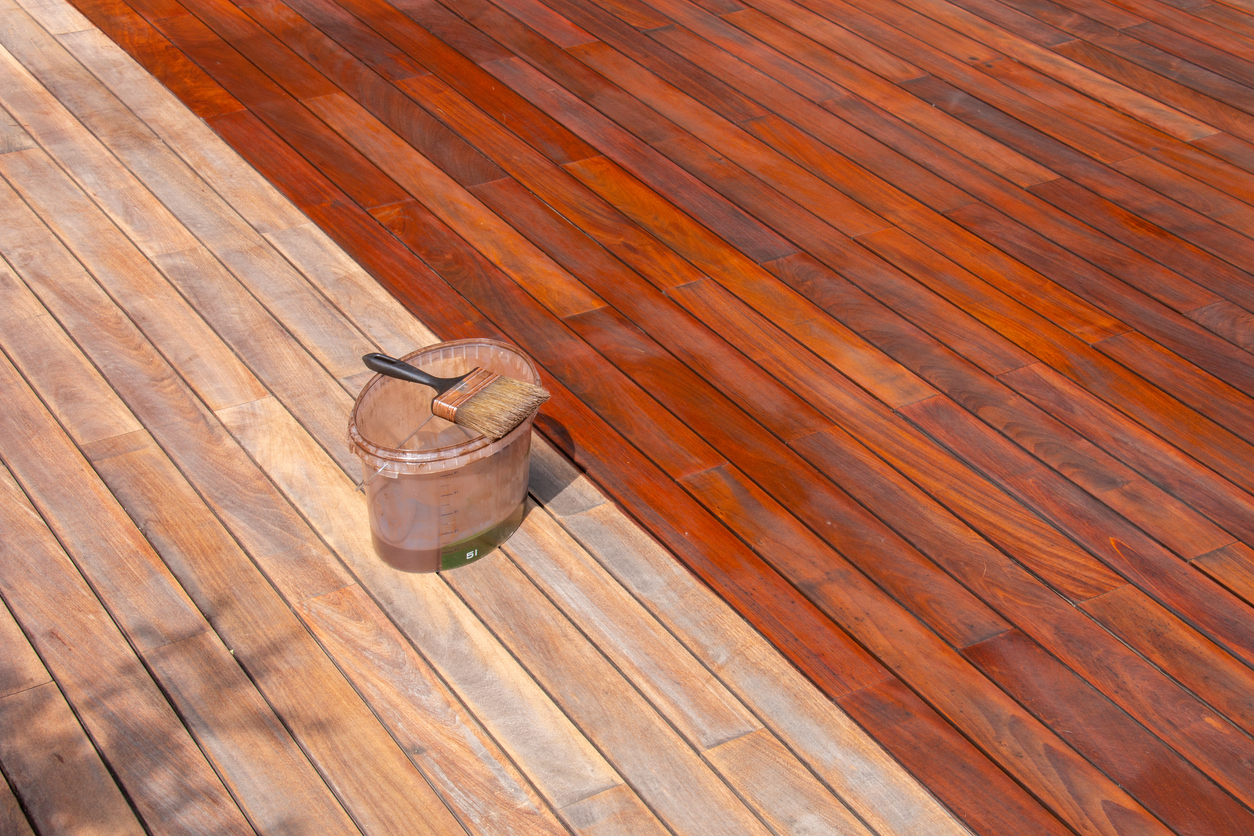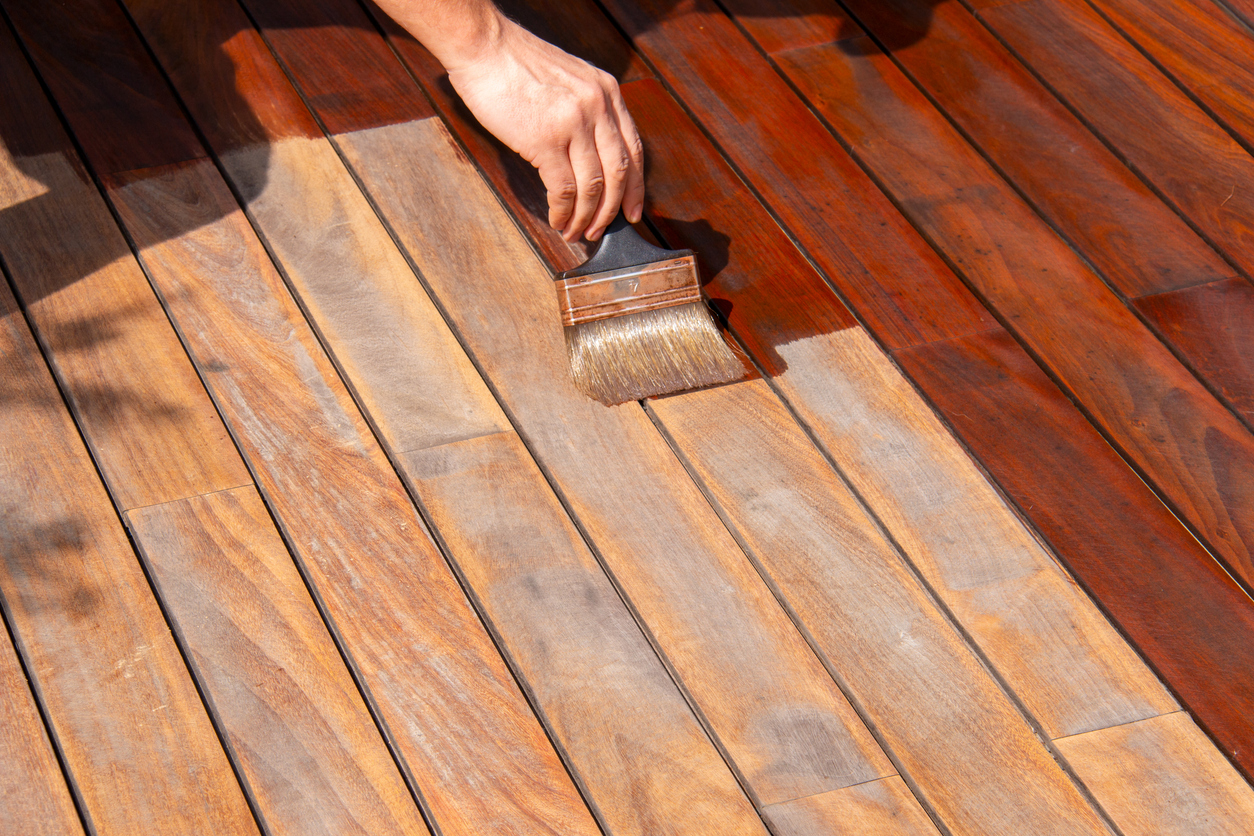A wooden deck can enhance the appearance of a new home. It is also a perfect spot for family gatherings and relaxation. But it should be protected from outdoor elements like rain and moisture to prevent wood rot. One of the best ways to do this is through deck staining. It is a process that protects wood from moisture, UV damage, and normal wear and tear.
Did you know that there are different techniques for staining decks? All of these can maintain the durability and aesthetic appeal of your deck. Read on to learn more about these deck staining strategies for newly constructed homes.
Understanding the Basics of Deck Staining
Deck staining is a way to maintain and enhance the quality and aesthetics of wooden decks. It includes the application of a protective stain to the wood. This process protects the wood from weathering, including UV rays, moisture, and temperature fluctuations. This protection helps prevent fading, cracking, and warping.
Types of Stains
Choosing the right stain can enhance the natural beauty of the wood grain to make the deck more visually appealing. Here are the several types of stains available:
- Transparent Stains: These stains are clear or lightly tinted and are designed to penetrate deeply into the wood while preserving the natural appearance of the grain. Transparent stains provide the least amount of UV protection and will require more frequent reapplication.
- Semi-Transparent Stains: Semi-transparent stains provide more UV protection than transparent stains while allowing some of the wood’s natural grain to show through. They are available in different shades and are a popular choice for those who want to enhance the deck’s natural colors.
- Solid Stains: These are more like paint and offer the highest level of protection against the elements. Solid stains completely cover the wood grain but come in a range of colors, allowing for better customization of your deck’s appearance. They are ideal for older decks that have weathered or those that have imperfections because they help cover flaws.
Choosing the Right Type of Stain
The appropriate type of stain is selected based on two factors: the type of wood on your deck and the climate in your area.
- Wood Type: Different woods absorb stains in different ways. Hardwoods, for example, may not absorb as much stain as softer woods. Knowing the characteristics of the wood can guide you in choosing a stain that will enhance its natural properties and ensure better adherence and longevity.
- Climate: Climate plays an important role in determining the best type of stain. In areas with high exposure to sunlight and UV rays, a stain with strong UV blockers or a solid stain might be necessary to prevent rapid deterioration. A stain with excellent water-resistant properties in moist or cooler climates can help prevent rot and mold growth.
Understanding these basics can help you choose the best staining strategy for your deck so that it remains a beautiful and functional outdoor space for many years.
Timing Your Stain Application
Staining too early or too late can lead to poor adhesion, diminished appearance, and reduced durability of the protective finish. Here’s how to determine the best time for staining your new deck:
Best Practices for When to Stain a New Deck
- Allowing the Wood to Cure: New wood typically contains a high level of moisture, which can interfere with the stain’s ability to penetrate effectively. We recommend allowing the wood to cure for at least six months before applying stain. This period allows excess moisture to evaporate for better stain absorption and adhesion.
- Weather Conditions: The best time to stain is during dry weather when temperatures are between 50°F and 90°F. High humidity or excessively hot temperatures can prevent the stain from curing properly. Staining should not be done just before rain is expected, as the stain needs time to dry completely after application.
Signs That Your Deck Wood is Ready for Staining
- Moisture Level: The wood should have a moisture content of 15% or less before staining. You can measure this using a wood moisture meter. This tool is essential to make sure that the wood is not too moist to hold the stain.
- Visual Inspection: Some of the signs that wood has begun to dry out include fading of the green tint or a lighter appearance. The wood should also feel dry to the touch.
- Water Test: Sprinkle a few water droplets onto the surface of the wood. The wood is not ready if the water beads up and is still too oily or moist for staining. The deck can absorb the stain if the water soaks in.
Consequences of Staining Too Early or Too Late
- Staining Too Early: Applying stain to wood that isn’t cured enough can trap moisture beneath the stain. This may lead to issues such as peeling, blistering, and mold growth. The stain may also fail to penetrate properly, leading to an uneven finish and poor coloration.
- Staining Too Late: Delaying the staining process can leave the wood unprotected against the elements for too long. This makes it vulnerable to sun damage, cracking, and warping. Untreated wood can degrade over time and affect both its aesthetics and structural integrity.
By understanding the importance of timing in the staining process and observing the condition of your deck wood, you can ensure that your staining job will enhance your deck’s beauty and longevity.
Preparing Your Deck for Staining
Proper preparation is essential in order to have a long-lasting stain on a new deck. This also ensures the stain adheres well and lasts longer. Here’s a step-by-step guide on how to prepare your new deck for staining:
Step-by-Step Guide
- Cleaning the Deck: Start by sweeping the deck thoroughly to remove all loose dirt, debris, and leaves. Then, use a deck cleaner to remove any mildew, stains, or old finishes. Apply the cleaner according to the manufacturer’s instructions, typically using a sprayer or a stiff brush to spread the cleaner evenly. Rinse the deck thoroughly with a hose or a power washer set on a low setting to avoid damaging the wood.
- Sanding the Deck: Once the deck is dry, sand the surface with medium-grit sandpaper (around 60 to 80 grit) to smooth out any rough spots and open up the pores of the wood for better stain absorption. Focus on sanding along the grain of the wood to avoid scratches. You can use a hand sander or a pole sander for larger decks to make it easier.
- Final Cleaning: It’s important to remove all the sawdust and residues after sanding. Sweep the deck again thoroughly and then wipe down the surface with a damp cloth or a tack cloth to pick up any lingering dust.
- Drying: Allow the deck to dry completely after cleaning and before applying the stain. This usually takes at least 24 to 48 hours in good weather conditions. Ensure that no rain is forecasted during this period.
Necessary Tools and Materials
- Broom and/or leaf blower
- Deck cleaner
- Sprayer or stiff brush
- Hose or power washer
- Sandpaper or power sander
- Tack cloth or damp rags
- Moisture meter (optional for checking wood moisture levels)
Tips for Ensuring a Clean and Receptive Surface
- Test the Surface: Before starting your preparation, test a small area of the deck to make sure that the cleaner and tools do not damage the wood.
- Use the Right Sandpaper: Do not use excessively coarse sandpaper because it can damage the surface of new wood. Medium grit is generally enough for new wood surfaces.
- Avoid Power Washing Errors: If using a power washer, keep it on a low setting and maintain a consistent distance from the deck surface to prevent scraping out the wood.
- Check Weather Conditions: Ideal conditions for deck preparation are dry with moderate temperatures. Avoid staining in direct sunlight or extreme temperatures because they can affect the drying and curing of the stain.
- Be Thorough: Spend enough time on each step, especially cleaning, as residual dirt or moisture can interfere with the staining process.
By following these detailed steps and using the proper tools and techniques, you can prepare your new deck effectively for an effective staining job that will keep it protected.
Application Techniques for Best Results
There are different application techniques that you can use to achieve even coverage and a good finish. Understanding them will help you get the best results. Here’s how to apply deck stain effectively:
- Choose the Right Day: Ensure that the weather is favorable, ideally dry and cool. Avoid staining in direct sunlight or when rain is predicted within 24 hours after application.
- Mix the Stain: Thoroughly mix the stain before applying it to evenly distribute all the color pigments and oils. If using multiple cans of the same stain, consider combining them in a large bucket to maintain color consistency throughout the application.
- Apply Stain in Sections: Work on one or two boards at a time from one end of the deck to the other to avoid lap marks. This technique ensures you maintain a wet edge, blending each section together while the stain is still wet.
- Use a Brush or Roller: Apply a generous amount of stain. Make sure it gets into the seams and gaps between the boards. A back brush or a roller is used to even out the stain. Work it into the wood grain for better absorption.
- Wipe-Off Excess Stain: After a few minutes, wipe off any excess stain that has not been absorbed by the wood. This prevents puddling and uneven drying, which can lead to a tacky finish.
- Allow to Dry: Refer to the stain manufacturer’s guidelines for drying times. Avoid using the deck until the stain has completely dried.
Brush vs. Roller vs. Sprayer
- Brush: This method provides the most control and is best for getting the stain into the wood grain. This is essential for deep penetration and even coverage. It’s especially effective for detailed areas and edges but can be time-consuming for large decks.
- Roller: Using a roller speeds up the process and is good for applying stains on large, flat areas. However, it can lead to uneven coverage and might not get the stain deep into the wood grain as effectively as a brush.
- Sprayer: This tool offers the fastest application and is ideal for large decks or rough surfaces where detail is less important. It requires careful handling to avoid overspray and uneven layers. Always back-brush after spraying to ensure the stain penetrates evenly and reduces the chance of drips.
Common Mistakes to Avoid
- Not Preparing the Surface Properly: Skipping sanding, cleaning, or drying fully can lead to poor stain adhesion and uneven color.
- Applying Too Much Stain: Over-applying can lead to sticky surfaces and longer drying times. It can also cause the stain to peel over time.
- Ignoring the Weather: Staining on a very hot day or before rainy weather can ruin your finish. Moisture in the wood or on the surface can prevent proper drying.
- Neglecting Edges and Ends: These areas are often overlooked but are critical for overall protection and aesthetics.
By choosing the right tools and techniques for your deck’s specific conditions and following these detailed steps, you can achieve a beautifully stained deck that not only looks great but also lasts longer.
Maintenance and Care Post-Staining
Proper care keeps your deck looking great and also extends its life. Here’s a guide to the initial maintenance after staining, routine inspections and touch-ups, and long-term care strategies.
Initial Maintenance Tips Following the First Staining
- Allow Proper Curing Time: Follow the stain manufacturer’s recommendations for curing time before placing furniture or plants back onto the deck. This can range from a few days to a week, depending on the type of stain and weather conditions.
- Avoid Water and Dirt: In the first few weeks post-staining, minimize exposure to water and dirt to allow the stain to set properly. Sweep the deck regularly to keep it free from debris and dirt.
- Position Rugs and Furniture Carefully: Use outdoor rugs and furniture pads that allow for airflow to prevent moisture buildup. This is important to avoid discoloration and degradation of the wood surface under items left in place for extended periods.
Scheduling Routine Inspections and Touch-Up Applications
- Biannual Inspections: Check your deck thoroughly at least twice a year, preferably in spring and fall. Look for signs of wear, such as fading stains, wood splinters, or cracks. Pay special attention to areas that are frequently wet or exposed to sunlight constantly.
- Touch-Up Stain: Areas that show signs of wear or water penetration may need a touch-up. Clean the area thoroughly and apply a matching stain according to the original application guidelines. This not only enhances the look but also reinforces the deck’s protection against the elements.
- Repair Damages Promptly: Replace or repair any broken boards or unstable sections of the deck. This prevents further damage and maintains the structural integrity of the deck.
Long-Term Care Strategies to Maintain the Deck’s Appearance and Integrity
- Regular Cleaning: Perform a deep cleaning at least once a year using a deck cleaner to remove grime, mildew, and built-up dirt. This keeps the surface looking fresh and can prevent organic growth that might damage the wood.
- Reapply Stain: Depending on the type of stain and your local climate, a full re-staining might be necessary every two to three years. This is crucial for maintaining the protective layer that helps the wood resist moisture, UV damage, and wear.
- Check for Moisture Issues: Ensure that the area around your deck has proper drainage and that water does not pool near or on the deck surface. Prolonged exposure to moisture can lead to wood rot and structural problems.
- Trim Plants and Trees: Keep foliage trimmed back to allow sunlight to reach the deck and minimize debris accumulation. This also prevents excess moisture and potential damage from plant growth.
Regular maintenance not only protects your investment but also enhances your enjoyment of your outdoor living space.
Conclusion
Proper staining and ongoing maintenance are essential to preserving the beauty and longevity of your deck. Regular care, routine inspections, and timely touch-ups will also keep your deck in top condition for years to come. If you need professional assistance or advice on deck staining and maintenance, you may contact us at Custom Painting, Inc. by calling 925-686-0903 or by using our online contact form. We’re here to help ensure your deck remains a standout feature of your home.



